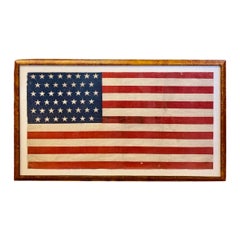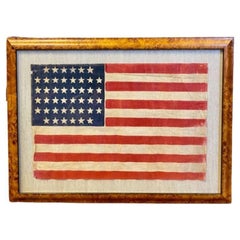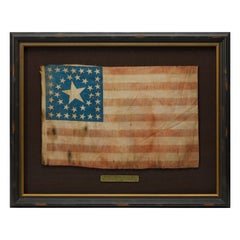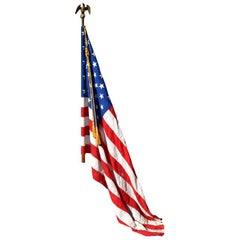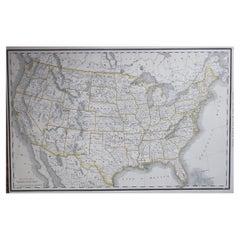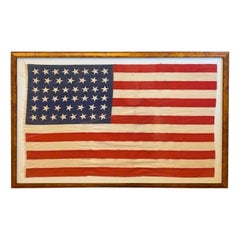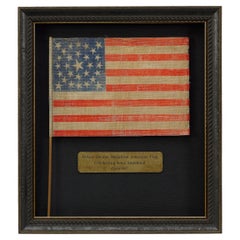Muslin Historical Memorabilia
3
to
3
3
3
3
3
194
832
433
400
188
3
3
Material: Muslin
American 45 Star Flag, circa 1896
Located in Nantucket, MA
Antique American 45 Star Flag, circa 1896, marking the admission of Utah into the Union as the 45th state in 1896. This was an official flag of the United States for only twelve yea...
Category
1890s American Federal Antique Muslin Historical Memorabilia
Materials
Muslin
American 44 Star Flag, circa 1891
Located in Nantucket, MA
Rare Antique American 44 Star Flag, circa 1891, marking admission of Wyoming as a state in 1891. This was an official flag of the United States for only five years, making it one of ...
Category
1890s American Federal Antique Muslin Historical Memorabilia
Materials
Muslin
38-Star Antique American Flag with Unique Canton, circa 1876-1890
Located in Colorado Springs, CO
This is a striking 38-star American flag. The flag dates to 1876-1890, when Colorado (represented by the large star in the center of the flag’s canton) joined the Union as the 38th s...
Category
Late 19th Century American Antique Muslin Historical Memorabilia
Materials
Muslin
Related Items
Antique Federal Eagle American 50 Star Flag with Brass Eagle Pole, 19th Century
Located in Oklahoma City, OK
Monumental 50 star American Flag with antique Federal Eagle brass and wood pole. A patriotic piece suitable for any home. This set includes both ...
Category
19th Century American Federal Antique Muslin Historical Memorabilia
Materials
Brass, Bronze
H 66 in W 69 in D 1.25 in
Large Original Antique Map of the United States of America. 1891
Located in St Annes, Lancashire
Fabulous map of The United States
Original color
By Rand, McNally & Co.
Dated 1891
Unframed
Free shipping.
Category
1890s American Antique Muslin Historical Memorabilia
Materials
Paper
No Reserve
H 20.5 in W 13.5 in D 0.07 in
46-Star American Flag, Antique Printed on Silk, Early 20th Century
Located in Colorado Springs, CO
This is an original 46-star American parade flag, printed on silk. Each star represents a state in the Union at the time. The official flag design would update every July 4th, to inc...
Category
Early 1900s American Antique Muslin Historical Memorabilia
Materials
Silk
39-Star Antique American Flag with 'Whimsical' Star Pattern, 1889
Located in Colorado Springs, CO
This is a 39-star unofficial American flag, handmade and printed on cotton. The flag dates to 1889 and has a unique history, thanks to its rare star-count.
The flag’s canton is prin...
Category
1880s American Antique Muslin Historical Memorabilia
Materials
Cotton
American flag in mahogany presentation cabinet
Located in Debenham, Suffolk
Here we present a traditionally folded American flag in mahogany glazed cabinet.
Complete with certificate to say that the flag was flown over th...
Category
Late 20th Century American Modern Muslin Historical Memorabilia
Materials
Fabric, Mahogany
American Mahogany Wood Antique Magnetic Binnacle Nautical Compass, circa 1896
Located in Milan, IT
Rare mahogany wood binnacle compass. Inside there is a liquid compass mounted on a universal joint signed D. Baker Melrose Mass Pat. 22 Sept 1896 and marketed by the Chas Company. C....
Category
1890s American Antique Muslin Historical Memorabilia
Materials
Brass
H 9.06 in W 11.82 in D 7.49 in
1889 North Dakota 39 Star United States of America Statehood Flag
Located in Coeur d'Alene, ID
39 star silk statehood flag. 23 1/2" x 15". Was the unofficial North Dakota Flag. As South Dakota was also admitted as the 40th state on the same day this...
Category
1880s American Antique Muslin Historical Memorabilia
Materials
Silk
Antique 46 Star WMH Horstmann Company United States of America Flag 83"
By Horstmann
Located in Dayton, OH
Antique forty six star large wool American flag by Horstmann Company, circa 1908-1912.
Horstmann firm was founded by William H. Horstmann (1785-1850), who had immigrated to Philadelphia from Germany. Horstmann bought out a local swordmaker in 1828 and thereafter entered the military goods field. The firm benefitted from the Civil War, becoming the largest military goods supplier in the nation by 1864.
WILLIAM H. HORSTMANN & SONS, Manufacturers of Dress Trimmings and Military Goods. 5th & Cherry Streets, Philadelphia, PA.
This house was founded, in 1815, by William H. Horstmann, a native of Cassel, in Germany. He had learned the trade of silk-weaving in France, and, emigrating to the United States in the above-mentioned year, established himself in Philadelphia as a manufacturer of fringe, laces and trimmings of various kinds. He married the daughter of Frederick Hoeckly, a German settler in Philadelphia, and also a manufacturer of fringe, coach-lace and tassels. He devised several improvements in this trade, especially by introducing varieties in the styles and patterns of this class of goods, there being at that time only two patterns used in the trade, which were known as the Jefferson pattern and the Monroe pattern.
In 1824, he introduced into this country from Germany the use of plaiting or braiding machines, and about the same time he was the first to introduce into this country the use of the Jacquard loom, for weaving patterns in textile fabrics. His location was in the first instance at No. 50 North Third street, but within a short time he removed to a store next to the Harp and Crown tavern, afterwards known as the City hotel, and continued his business within a short distance of this point for many years.
In 1828, he commenced the manufacture of military trimmings as a special department, and this branch has grown to most important proportions, Horstmann's military goods being in demand throughout time country. The firm have also executed large Government contracts in this line for the War and Navy Departments. In 1831, he established a branch house in New York city, and about the same time erected a factory at the corner of Germantown road and Columbia avenue. The factory was continued here until time erection of the extensive building at Fifth and Cherry streets, where the works, salesrooms and offices of time firm now are. This massive structure is six stories high, and extends 140 feet on Fifth street and 200 on Cherry street, and reaches back to Race street. The separate departments into which the business is divided are thirty in number. More than 1000 distinct looms and machines are in use in the building, many of them very costly and some invented and used exclusively by this firm, the motive power being supplied by a steam engine of fifty horse power. The area covered by the works is about 11,000 square feet. Time number of hands employed is very large, about 500. When the erection of a vast factory at this point was first proposed, a strong opposition was made by time holders of the neighboring property. The ancient German Lutheran Church and burying ground, since removed, stood opposite the site, and a bill was introduced into the Legislature to forbid the use of a steam engine within 100 yards of any place of worship. The interests which such a bill would have affected injuriously, especially those of several newspapers, roused a strong opposition to it, and it failed to become a law. In 1845, William H. Horstmann, the founder of the house, retired from the business, and his two sons, William and Sigmund, assumed the management and it was under their direction that the new building, above described, was erected.
The goods produced by this house are of almost endless extent and variety. They include goods woven from all the various textile fibres—cotton, wool, silk, etc.—in every style, color and pattern, and are used for an infinite number of purposes. Narrow woven goods are time staple production, made up into material for dresses for both sexes, for use in daily life, and for regalia for ""societies;"" for the costumes of the stage, the upholstering of houses and of carriages, the uniforms of soldiers, together with equipments for the same, and for funeral purposes. The raw material used in the manufacture is to a great extent very costly, and their store rooms often hold as much as $200,000 worth of goods in an unworked state. There are two rooms devoted to power looms in the factory, one for coach lace and one for other styles of weaving, in which about 250 of these machines are constantly running. The braiding machines in the coach lace room are very noteworthy. The cord to be covered with braid is drawn through an opening in time middle of a flat, circular, metallic plate, about 15 inches across. Up to a point on this cord, about a foot above the plate, the threads of the braiding material converge, like the ribs of a tent-roof, and there weave in and out and out and in, as the coating of braid grows, and time covered cord rises and is wound away above. The weaving is accomplished by the motion of the spools below that carry the different threads of the braid. These spools stand in uprights, which are carried round and amongst each other in curved slots in the above-mentioned broad metallic plate. All but two of these spools run in and out among each other, with a swift, easy and intricate motion, mind so rapid that time eye can hardly follow it, while one or two special spools run steadily round and round among time twisting spools with the most extreme swiftness. Many other machines, displaying equally ingenious mechanism, are used in the factory. The various details of equipment manufactured and supplied by this house are also important, both for their number and the superior quality of the manufacture.
The one article of swords may be taken as an instance. This trade grew naturally and immediately out of the established army and navy goods department of the works, it being necessary that the sword itself should be furnished together with the sword-belt and other trappings all complete. Every part of the sword and trappings, with the exception of the blade, is made on the premises. The blades are almost all imported from the ancient German sword-blade emporium of Solingen, where, it is said, swords have been made ever since the year 1147, when Count Adolphus of Berg brought home from the East and established there the business of forging Damascus blades. There is in this department a stock of some thousands of blades, of many different patterns and sizes, ready to be set and finished. Any style or sword can be had from this warehouse, from the plainest kind up to a presentation sword...
Category
1910s American Classical Vintage Muslin Historical Memorabilia
Materials
Wool
34-Star Civil War American Flag, Antique Great Star Pattern, circa 1861
Located in Colorado Springs, CO
The stars of this extremely rare, Civil War-era flag are arranged in what is sometimes called the "Great Flower" pattern, a large star made out of smaller stars -- named as such beca...
Category
1860s American Antique Muslin Historical Memorabilia
Materials
Linen
Vintage Framed 48 Star American Flag
Located in west palm beach, FL
An incredible vintage Monumental American flag. A chic vintage 48 star version in great vintage condition. The 48 star flag was last used in 1959. Professionally mounted and framed. ...
Category
Mid-20th Century American American Classical Muslin Historical Memorabilia
Materials
Fabric, Plexiglass, Wood
46-Star American Flag Printed in Drum Star Configuration
Located in Colorado Springs, CO
This is an original 46-Star American parade flag, celebrating Oklahoma statehood. Each star on the flag's canton represents a state in the Union at the time. The official flag design would update every July 4th, to include any new states added to the Union in the past year. Oklahoma, the 46th state, entered the Union on November 16, 1907. As such, this 46–star flag was the official flag of the United States from July 4, 1908, until July 4, 1912.
The silk flag has a dark blue canton with 46 white printed stars. The stars are printed in an 7-8-8-8-8-7 row configuration, or “Drum design.” The flag design is completed with 13 alternating red and white stripes, each stripe representing one of the original thirteen colonies.
The land that comprises Oklahoma today was added to the United States as part of the Louisiana Purchase of 1803. Throughout the 19th century, the U.S. government relocated Indian tribes from the southeastern United States to the area, and by 1900, over 30 Indian tribes had been moved to what was originally called the Indian Territories. At the same time, ranchers in Texas began to move into the area in search of new pasture lands. Although stipulations in the Indian Relocation Act agreed that the land would forever be Indian Territory, the promise of fertile farmland trumped the government’s promise of sovereignty.
On April 22, 1889, they opened the land to settlement by homesteaders, creating a land run in which settlers, called “Boomers,” were allowed to cross the Texas or Arkansas border at a particular hour to claim homesteads. Settlers who illegally crossed the border earlier to stake prime land were called “sooners,” which eventually became the state’s nickname. Wagons and the Santa Fe railroad carried cartloads of men and women to blank town sites and building plots, creating ten thousand-people communities in a matter of days. The following year, the region was further divided into Indian Territory and Oklahoma Territory...
Category
1910s American Vintage Muslin Historical Memorabilia
Materials
Silk
Rare Monumental 1890 Antique 42 Star United States of America Flag
Located in Dayton, OH
Monumental fifteen foot 42 star American flag, circa 1889-1890.
The 42-star flag is rare because only a limited number of 42-star flags were produced after Washington became a state on Nov. 11, 1889.
But it takes a more intimate knowledge of flag trivia to know just why it happened this way.
White stars are added to the blue field of the star-spangled banner on the Fourth of July after a state is admitted to the union. In the fall of 1889, several western territories became states.
Dakota was admitted, and then split into North and South Dakota, on Nov. 2, 1889, which made them state and star numbers 39 and 40. Montana was named the 41st state on Nov. 8, followed by Washington, on Nov. 11.
Only a few flag manufacturers began producing 42-star flags before the official addition of the 42nd star on July 4, 1890.
Those who tried to jump the gun by being the first to produce an up-to-date flag were surprised when Idaho was admitted to the United States on July 3...
Category
1890s American Classical Antique Muslin Historical Memorabilia
Materials
Cotton
Previously Available Items
19th Century American 45 Star Flag
Located in Nantucket, MA
Antique American 45 star flag, circa 1896, a printed muslin flag with a "Dancing Star" pattern arranged in an 8 - 7 ---8 - 7 -8 - 7 format. This was an of...
Category
1890s American Federal Antique Muslin Historical Memorabilia
Materials
Muslin
29-Star Printed Double-Medallion American Parade Flag, Iowa Statehood, 1847
Located in Colorado Springs, CO
This is a rare 29-star medallion American flag, celebrating the addition of Iowa to the Union. The flag is printed on glazed muslin, and has a spectacularly unique star pattern. A do...
Category
1840s American Antique Muslin Historical Memorabilia
Materials
Muslin
45-Star American Flag Printed on Muslin, 1896-1907
Located in Colorado Springs, CO
This 45-star United States flag celebrates the statehood of Utah. 45-star flags served as the official American flag from 1896-1908. The flag is printed on muslin and was flown as a ...
Category
Early 20th Century American Muslin Historical Memorabilia
Materials
Muslin
God Save The King Vintage Patriotic Banner Flag, circa 1930
Located in Colorado Springs, CO
This vintage celebratory banner reads, “GOD SAVE THE KING” in bold white and split red and blue letters, set against a red, white, and blue striped f...
Category
1930s British Vintage Muslin Historical Memorabilia
Materials
Muslin
46-Star Antique American Flag Waver on Stick, circa 1908
Located in Colorado Springs, CO
Presented is a flag waver from 1908 with 46 stars. This small flag waver, commonly printed to wave in parades, celebrates Oklahoma statehood. Oklahoma was admitted into the Union in ...
Category
Early 1900s American Antique Muslin Historical Memorabilia
Materials
Muslin
42-Star Antique American Parade Flag, circa 1889
Located in Colorado Springs, CO
Presented is a 42-star parade flag printed circa 1889. It features a whimsical, dancing star pattern against a dark blue canton. The stars are arranged in six rows with seven stars e...
Category
1880s American Antique Muslin Historical Memorabilia
Materials
Muslin
40-Star Antique Parade Flag Printed on Muslin, circa 1889
Located in Colorado Springs, CO
Presented is a 40-star "unofficial" printed flag. This parade flag celebrates South Dakota statehood, which was granted along with North Dakota on November 2, 1889. In addition to No...
Category
1880s American Antique Muslin Historical Memorabilia
Materials
Muslin
38-Star Antique Printed American Flag, circa 1876-1890
Located in Colorado Springs, CO
This is an exceptional 38-star printed American flag. The flag dates to 1876-1890, when Colorado joined the Union as the 38th state. A wonderful celebration of the nation's early his...
Category
Late 19th Century American Antique Muslin Historical Memorabilia
Materials
Muslin
36-Star Antique American Flag with Rare Haloed Star Medallion, circa 1865
Located in Colorado Springs, CO
This 36-star flag has stars arranged in a gorgeous and highly desirable medallion pattern. This particular medallion includes a large haloed star in the middle, two rings of stars su...
Category
1860s American Antique Muslin Historical Memorabilia
Materials
Muslin
13-Star Circular Pattern Printed Centennial Flag Waver, 1876
Located in Colorado Springs, CO
Offered is a unique 13-star flag waver dating to the centennial year, 1876. The flag features a unique, printed star pattern. A large center star is surrounded by one encircling medallion of stars with four outlying stars at each corner. The flag's design is completed with 13 alternating red and white stripes. The original waver is presented on a wooden dowel and would have been used in parades or other events celebrating the centennial.
The original use of the thirteen-star flag dates to June 14, 1777, when the Continental Congress adopted a resolution creating the first official flag. The resolution stated, “Resolved, that the flag of the United States be made of thirteen stripes, alternate red and white, that the union be thirteen stars, white on a blue field, representing a new constellation.” Thirteen-star flags were official from 1777-1795, but are still used even today to celebrate significant historical markers. Small US Navy boats used thirteen stars as their ensign from 1795 until 1916. Thirteen-star flags were also flown at the time of George Washington’s death in 1799, in honor of General...
Category
1870s American Antique Muslin Historical Memorabilia
Materials
Muslin
38-Star Medallion Pattern American Flag with Two Outliers, circa 1876
Located in Colorado Springs, CO
This is a striking original 38-star United States flag. A wonderful celebration of our nation's early history, this flag is an authentic antique, dating circa 1877-1890.
In lead u...
Category
1870s American Antique Muslin Historical Memorabilia
Materials
Muslin
Recently Viewed
View AllMore Ways To Browse
Imperial Navy
Herb Bottle
Antique Coins Us
Us Antique Coins
Antique Us Coins
Red Gum
Mal Furniture
Antique German Christmas
Antique Slavery
Antique Sewing Collectables
United States Constitution
Military Bell
Bird Tree Ornaments
Vintage Christmas Tree Ornaments
Art Metal Construction Co
Century Of Progress Chicago
Antique Furniture Kansas City
Wwi German
